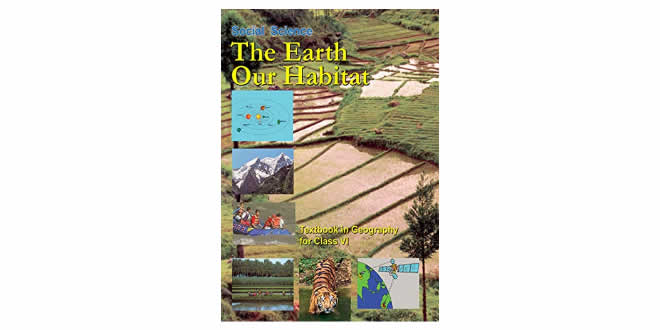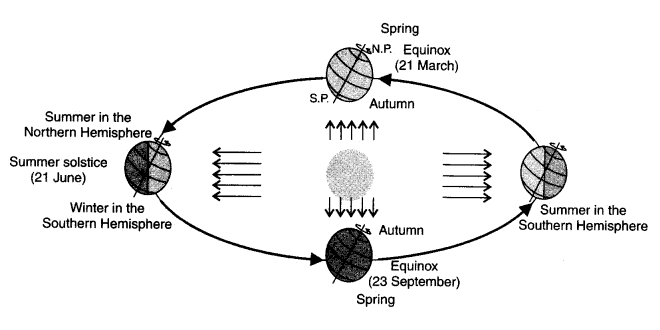Motions of the Earth – 6th Class NCERT CBSE Social Science (Geography) Chapter 03
Question: Answer the following questions briefly.
- What is the angle of inclination of the earth’s axis with its orbital plane?
- Define rotation and revolution.
- What is a leap year?
- Differentiate between the summer solstice and winter solstice.
- What is an equinox?
- Why does the Southern Hemisphere experience winter and summer solstice in different times than that of the Northern Hemisphere?
- Why do the poles experience about six months day and six months night?
Answers:
- The angle of inclination of the earth’s axis with its orbital plane is 66’/a.
- The movement of the earth on its axis is known as rotation. ‘Revolution. The movement of the earth around the sun in a fixed path or orbit is known as revolution.
- The year in which February is of 29 days instead of 28 days is called a leap year. Thus a leap year is of 366 days instead of 365 days.
- Difference between summer solstice and winter solstice:
Summer solstice: In the Northern Hemisphere the longest day and the shortest night occur on 21st June. At this time in the Southern Hemisphere it occurs the shortest day and the longest night. This position of the earth is called summer solstice.
Winter solstice: In the Northern Hemisphere the shortest day and the longest night occur on 22nd December. At this time in the Southern Hemisphere it occurs the longest day and the shortest night. This position of the earth is known as winter solstice. - On 21st March and September 23rd, direct rays of the sun fall on the equator. At this position, neither of the poles is tilted towards the sun. Therefore, the entire earth experiences equal days and equal nights. This phenomenon is called an equinox.
- Since it is winter in the Southern Hemisphere when it is summer in the Northern Hemisphere, therefore the position of the earth ‘which is called the Winter Solstice in one Hemisphere is the Summer Solstice in the other, and vice-versa.
- The axis of the earth is tilted, due to which the sun continuously either shines or cannot be seen for a long time here. Although the earth rotates and day changes into night and night into day at other places, but the poles remain under the same stage for a much longer time due to the tilt.
Motions of the Earth – Question: Tick the correct answer.
- The movement of the earth around the sun is known as
(i) Rotation (ii) Revolution (iii) Inclination. - Direct rays of the sun fall on the equator on
(i) 21 March (ii) 21 June (iii) 22 December. - Christmas is celebrated in summer in
(i) Japan (ii)India (iii)Australia - The cycle of the seasons is caused due to
(i) Rotation (ii)Revolution (iii)Gravitation
Answers:
- (ii)
- (i)
- (iii)
- (ii)
Question: Fill in the blanks.
- A leap year has ………… number of days.
- The daily motion of the earth is ……… ……
- The earth travels around the sun in…………….
- The sun’s rays fall vertically on the Tropic of…………….. on 21st June.
- Days are shorter during …………
Answer:
- 366
- rotation
- elliptical
- cancer
- winter.
Question: II. Fill in the Blanks
Fill in the blanks with appropriate words to complete each sentence: .
- Days and nights occur due to …………… of the earth.
- Only half of the earth gets light from the sun at a time due to its……………. shape.
- The period of rotation is known as the ……………..
- The sun’s rays fall vertically at the Tropic of…………….. on 22nd December.
- On ………… it is autumn season in the Northern Hemisphere and spring in the Southern Hemisphere.
Answer:
- rotation
- spherical
- earth day
- Capricorn
- 23rd September
True / False
Question: III. State whether these sentences are true (T) or false (F).
- The axis of the earth makes an angle of 23 V & with its orbital plane.
- Every five year, February is of 29 days instead of 28 days.
- Season changes due to the change in the position of the earth around the sun.
- When there is summer in the Northern Hemisphere, it is spring in the Southern Hemisphere.
- Life is not possible in extreme conditions.
Answer:
- False
- False
- True
- False
- True
Question: IV. Matching Skill
Match the items in column A correctly with those given in column B.
(i) Summer solstice
(ii) Winter solstice
(iii) Equinox
(iv) Orbit
(v) Rotation
(a) Daily motion of the earth
(b) 23rd September
(c) Fixed path
(d) 22nd December
(e) 21 st June
Answer:
- (e)
- (d)
- (b)
- (c)
- (a)
Question: Define circle of illumination.
Answer: The circle that divides the day from night on the globe is known as circle of illumination.
Question: Which motion of earth is associated with the changes in season?
Answer: Revolution
Motions of the Earth – Question: Why do seasons change?
Answer: Seasons change due to the change in the position of the earth around the sun.
Question: Why do the areas near the poles receive less heat?
Answer: It is because the rays of the sun are slanting on the poles.
Question: When do the longest day and the shortest night occur in the Northern Hemisphere?
Answer: On 21st June.
Motions of the Earth – Question: In which Hemisphere does Australia lie?
Answer: Australia lies in the Southern Hemisphere.
Question: What would happen if the earth did not rotate?
Answer: In such a condition the portion of the earth facing the sun would always experience day, and thus there would be continuous warmth in the region. At the same time the other half would always remain dark and be freezing cold all the time. These are extreme conditions which are not suitable for life. Thus, we can say that if the earth did not rotate life would not have been possible.
Question: How does leap year occur?
Answer: The earth takes 365.25 days i.e. one year to complete one revolution around the sun. We consider a year as consisting of 365 days only and ignore six hours for our convenience. Six hours saved every year are added to make one day i.e. 24 hours over a span of four years. This surplus day is added to the month of February. Thus every fourth year, February of 29 days instead of 28 days. Such a year with 366 days is called a leap year.
Motions of the Earth – Question: Explain the following with a diagram:
- Summer solstice
- Winter solstice
- Equinox
Answer:
- Summer solstice: The Northern Hemisphere is tilted towards the sun on 21st June. As the rays of the sun fall directly on the Tropic of Cancer, these areas receive more heat. But the areas size to the poles receive less heat due to the slanting rays of the sun. The North Pole is inclined towards the sun the places beyond the Arctic Circle experience continuous daylight for about six months. Since a large area of the Northern Hemisphere is getting light from the sun, it is summer in the regions north of the equator. The longest day and the shortest night at these places occur on 21st June. These conditions are reversed in the Southern Hemisphere at this time. It is winter season there having longer nights and shorter days. This position of the earth is known as the summer solstice.
- Winter solstice: On 22nd December, the Tropic of Capricorn receives direct rays of the sun as the South Pole tilts towards it. As the sun’s rays fall vertically at the Tropic of Capricorn, a larger portion of the Southern Hemisphere gets light. Hence, the Southern Hemisphere enjoys summer having longer days and shorter nights. This position of the earth is called the winter solstice.
- Equinox: On 21st March and 23rd September direct rays of the sun fall on the equator. At this position, neither of the poles is tilted towards the sun. As result, the entire earth experiences equal days and equal nights. This phenomenon is known as an equinox.
 Class Notes NCERT Solutions for CBSE Students
Class Notes NCERT Solutions for CBSE Students



